University Healthcare Information System Implementation Report
VerifiedAdded on 2020/02/24
|26
|6450
|214
Report
AI Summary
This report provides a comprehensive analysis of information system implementation within a healthcare environment. It begins with a requirements specification report, including a literature review on information systems, critical success factors, and system components. It then delves into the business processes of a hospital, outlining the general procedures from patient registration to diagnosis and treatment. The report continues with design specifications, including business process modeling, functional and non-functional requirements (such as database, reporting, authorization, scalability, and availability), and a proposal for a cloud solution using Infrastructure as a Service (IaaS) with a focus on Service Level Agreements (SLAs). The SLA discussion covers the importance of SLAs for cloud solutions, key performance indicators, and requirements for SLA formulation. Finally, the report concludes with a performance test plan for the proposed design.
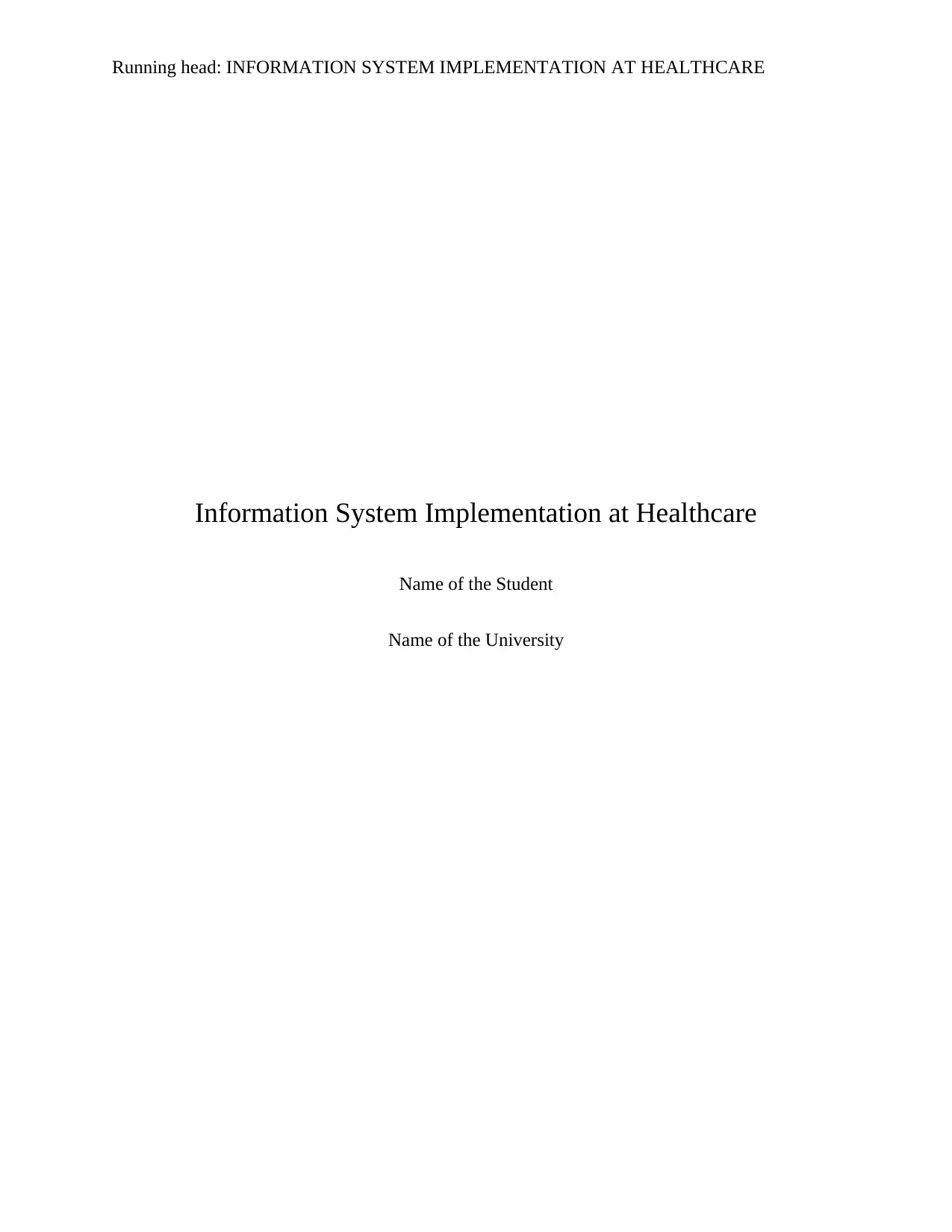
Running head: INFORMATION SYSTEM IMPLEMENTATION AT HEALTHCARE
Information System Implementation at Healthcare
Name of the Student
Name of the University
Information System Implementation at Healthcare
Name of the Student
Name of the University
Paraphrase This Document
Need a fresh take? Get an instant paraphrase of this document with our AI Paraphraser
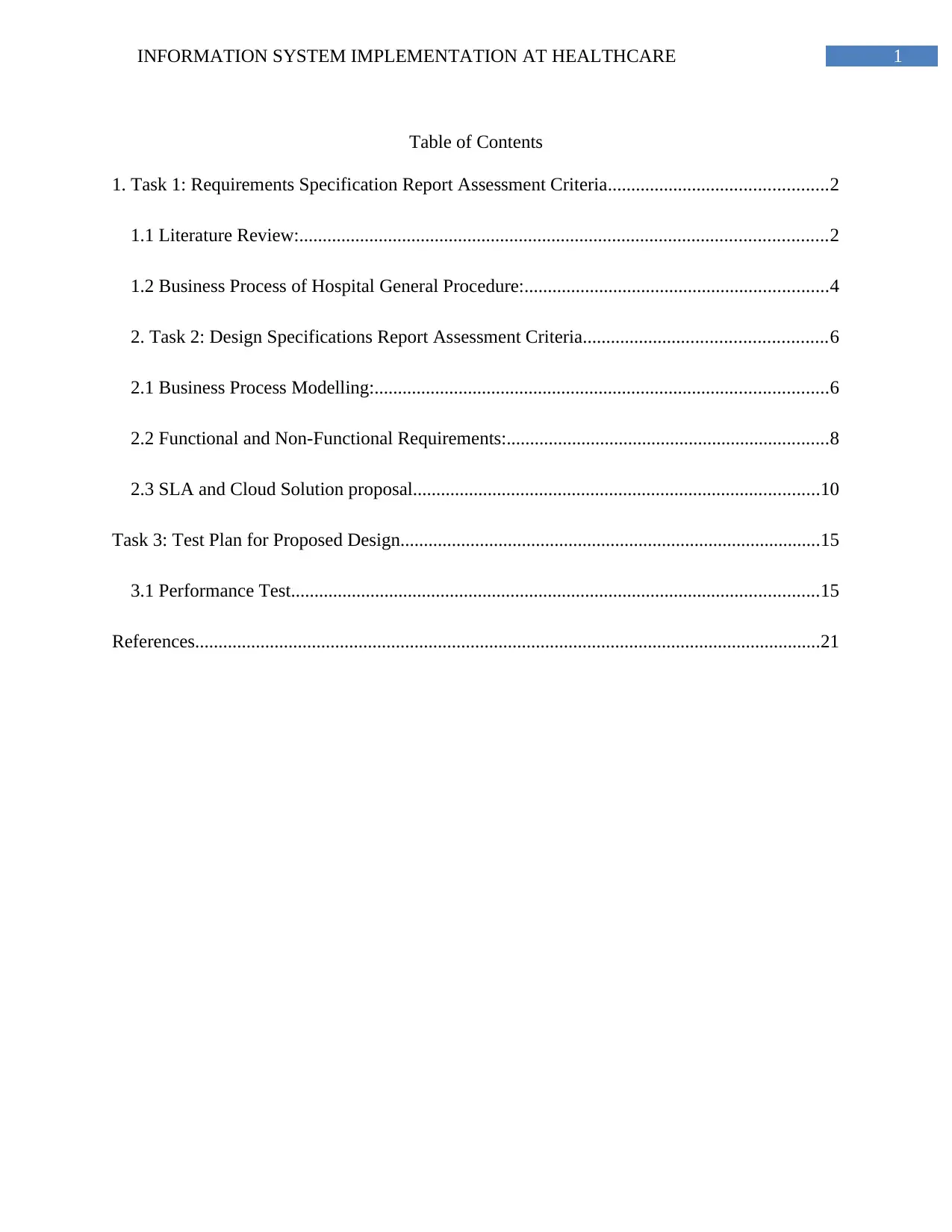
1INFORMATION SYSTEM IMPLEMENTATION AT HEALTHCARE
Table of Contents
1. Task 1: Requirements Specification Report Assessment Criteria...............................................2
1.1 Literature Review:.................................................................................................................2
1.2 Business Process of Hospital General Procedure:.................................................................4
2. Task 2: Design Specifications Report Assessment Criteria....................................................6
2.1 Business Process Modelling:.................................................................................................6
2.2 Functional and Non-Functional Requirements:.....................................................................8
2.3 SLA and Cloud Solution proposal.......................................................................................10
Task 3: Test Plan for Proposed Design..........................................................................................15
3.1 Performance Test.................................................................................................................15
References......................................................................................................................................21
Table of Contents
1. Task 1: Requirements Specification Report Assessment Criteria...............................................2
1.1 Literature Review:.................................................................................................................2
1.2 Business Process of Hospital General Procedure:.................................................................4
2. Task 2: Design Specifications Report Assessment Criteria....................................................6
2.1 Business Process Modelling:.................................................................................................6
2.2 Functional and Non-Functional Requirements:.....................................................................8
2.3 SLA and Cloud Solution proposal.......................................................................................10
Task 3: Test Plan for Proposed Design..........................................................................................15
3.1 Performance Test.................................................................................................................15
References......................................................................................................................................21
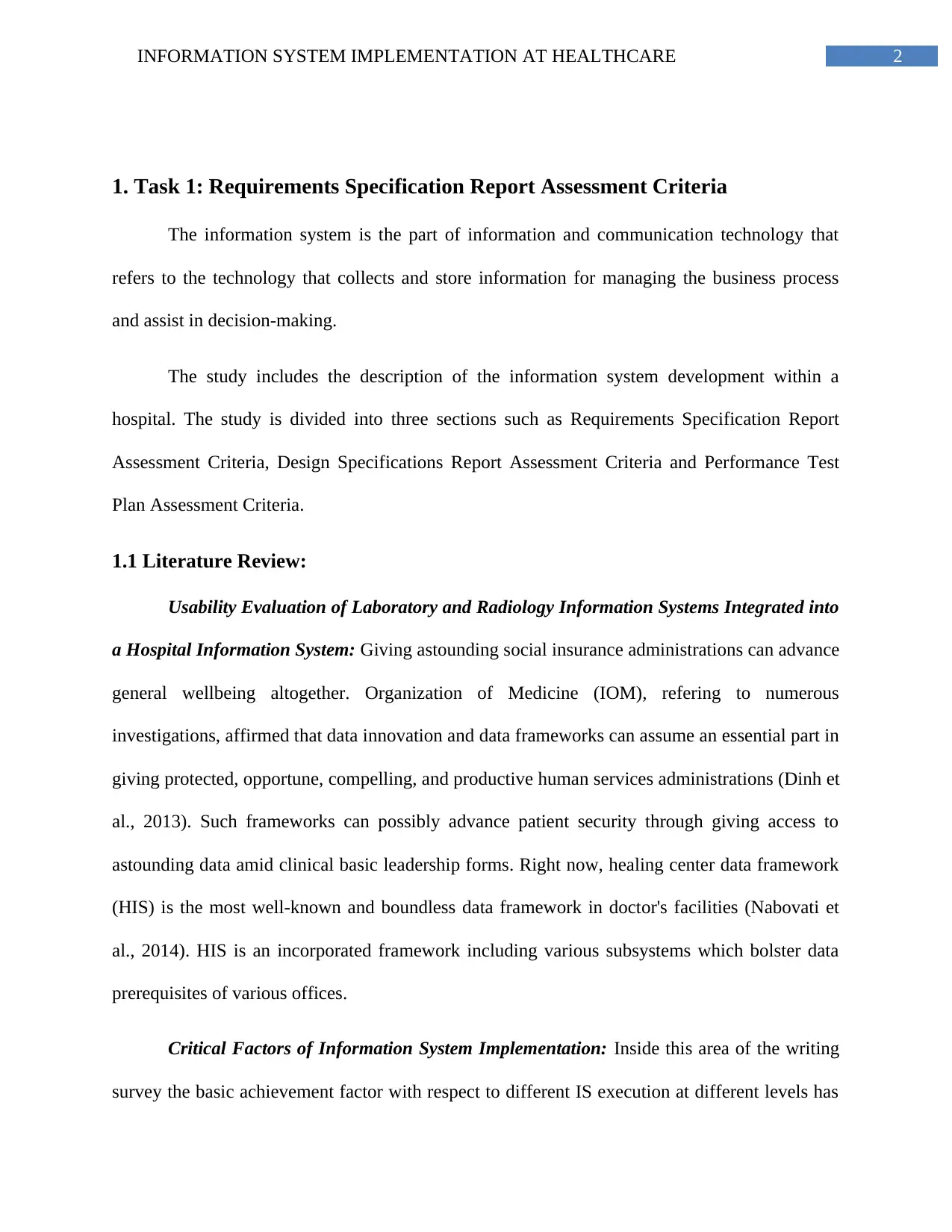
2INFORMATION SYSTEM IMPLEMENTATION AT HEALTHCARE
1. Task 1: Requirements Specification Report Assessment Criteria
The information system is the part of information and communication technology that
refers to the technology that collects and store information for managing the business process
and assist in decision-making.
The study includes the description of the information system development within a
hospital. The study is divided into three sections such as Requirements Specification Report
Assessment Criteria, Design Specifications Report Assessment Criteria and Performance Test
Plan Assessment Criteria.
1.1 Literature Review:
Usability Evaluation of Laboratory and Radiology Information Systems Integrated into
a Hospital Information System: Giving astounding social insurance administrations can advance
general wellbeing altogether. Organization of Medicine (IOM), refering to numerous
investigations, affirmed that data innovation and data frameworks can assume an essential part in
giving protected, opportune, compelling, and productive human services administrations (Dinh et
al., 2013). Such frameworks can possibly advance patient security through giving access to
astounding data amid clinical basic leadership forms. Right now, healing center data framework
(HIS) is the most well-known and boundless data framework in doctor's facilities (Nabovati et
al., 2014). HIS is an incorporated framework including various subsystems which bolster data
prerequisites of various offices.
Critical Factors of Information System Implementation: Inside this area of the writing
survey the basic achievement factor with respect to different IS execution at different levels has
1. Task 1: Requirements Specification Report Assessment Criteria
The information system is the part of information and communication technology that
refers to the technology that collects and store information for managing the business process
and assist in decision-making.
The study includes the description of the information system development within a
hospital. The study is divided into three sections such as Requirements Specification Report
Assessment Criteria, Design Specifications Report Assessment Criteria and Performance Test
Plan Assessment Criteria.
1.1 Literature Review:
Usability Evaluation of Laboratory and Radiology Information Systems Integrated into
a Hospital Information System: Giving astounding social insurance administrations can advance
general wellbeing altogether. Organization of Medicine (IOM), refering to numerous
investigations, affirmed that data innovation and data frameworks can assume an essential part in
giving protected, opportune, compelling, and productive human services administrations (Dinh et
al., 2013). Such frameworks can possibly advance patient security through giving access to
astounding data amid clinical basic leadership forms. Right now, healing center data framework
(HIS) is the most well-known and boundless data framework in doctor's facilities (Nabovati et
al., 2014). HIS is an incorporated framework including various subsystems which bolster data
prerequisites of various offices.
Critical Factors of Information System Implementation: Inside this area of the writing
survey the basic achievement factor with respect to different IS execution at different levels has
⊘ This is a preview!⊘
Do you want full access?
Subscribe today to unlock all pages.

Trusted by 1+ million students worldwide
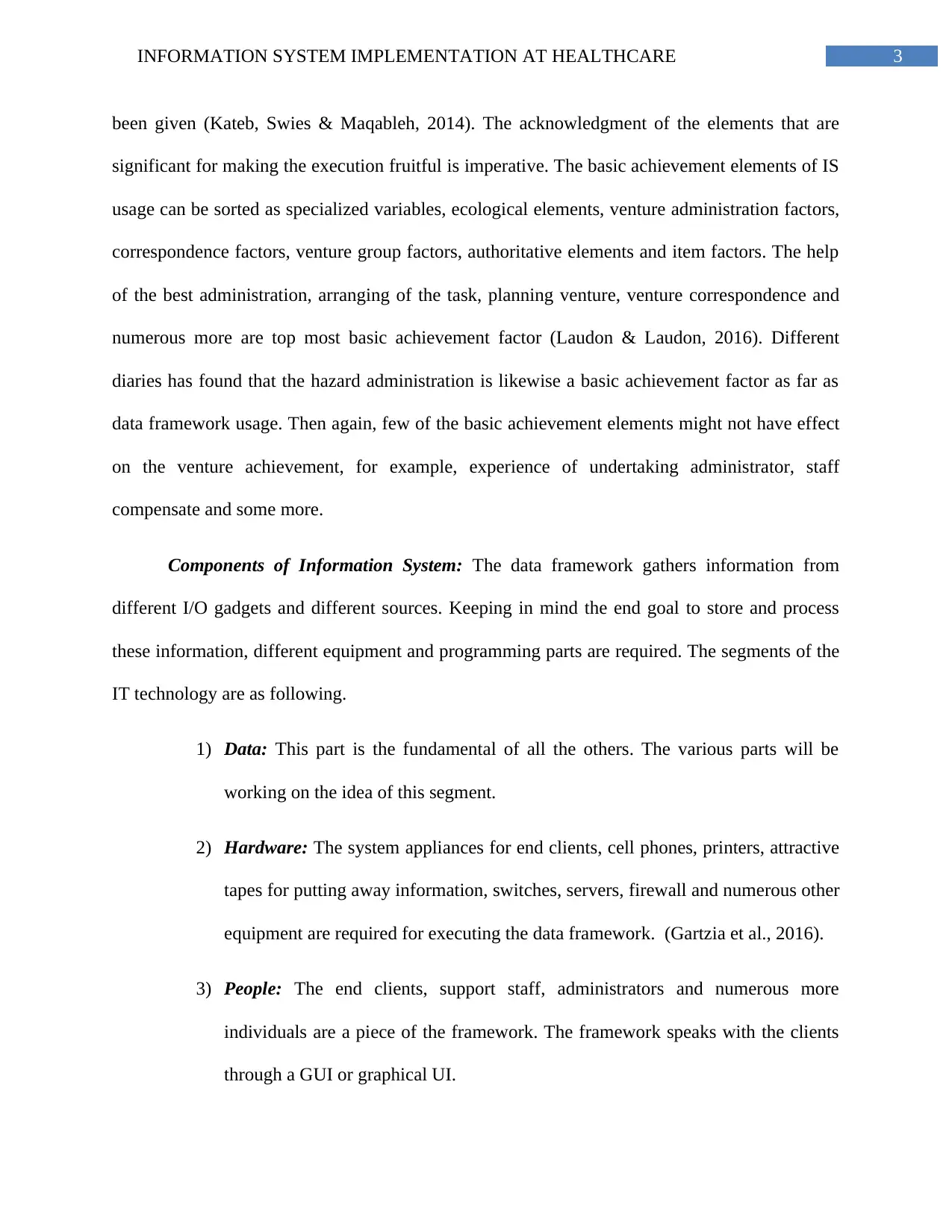
3INFORMATION SYSTEM IMPLEMENTATION AT HEALTHCARE
been given (Kateb, Swies & Maqableh, 2014). The acknowledgment of the elements that are
significant for making the execution fruitful is imperative. The basic achievement elements of IS
usage can be sorted as specialized variables, ecological elements, venture administration factors,
correspondence factors, venture group factors, authoritative elements and item factors. The help
of the best administration, arranging of the task, planning venture, venture correspondence and
numerous more are top most basic achievement factor (Laudon & Laudon, 2016). Different
diaries has found that the hazard administration is likewise a basic achievement factor as far as
data framework usage. Then again, few of the basic achievement elements might not have effect
on the venture achievement, for example, experience of undertaking administrator, staff
compensate and some more.
Components of Information System: The data framework gathers information from
different I/O gadgets and different sources. Keeping in mind the end goal to store and process
these information, different equipment and programming parts are required. The segments of the
IT technology are as following.
1) Data: This part is the fundamental of all the others. The various parts will be
working on the idea of this segment.
2) Hardware: The system appliances for end clients, cell phones, printers, attractive
tapes for putting away information, switches, servers, firewall and numerous other
equipment are required for executing the data framework. (Gartzia et al., 2016).
3) People: The end clients, support staff, administrators and numerous more
individuals are a piece of the framework. The framework speaks with the clients
through a GUI or graphical UI.
been given (Kateb, Swies & Maqableh, 2014). The acknowledgment of the elements that are
significant for making the execution fruitful is imperative. The basic achievement elements of IS
usage can be sorted as specialized variables, ecological elements, venture administration factors,
correspondence factors, venture group factors, authoritative elements and item factors. The help
of the best administration, arranging of the task, planning venture, venture correspondence and
numerous more are top most basic achievement factor (Laudon & Laudon, 2016). Different
diaries has found that the hazard administration is likewise a basic achievement factor as far as
data framework usage. Then again, few of the basic achievement elements might not have effect
on the venture achievement, for example, experience of undertaking administrator, staff
compensate and some more.
Components of Information System: The data framework gathers information from
different I/O gadgets and different sources. Keeping in mind the end goal to store and process
these information, different equipment and programming parts are required. The segments of the
IT technology are as following.
1) Data: This part is the fundamental of all the others. The various parts will be
working on the idea of this segment.
2) Hardware: The system appliances for end clients, cell phones, printers, attractive
tapes for putting away information, switches, servers, firewall and numerous other
equipment are required for executing the data framework. (Gartzia et al., 2016).
3) People: The end clients, support staff, administrators and numerous more
individuals are a piece of the framework. The framework speaks with the clients
through a GUI or graphical UI.
Paraphrase This Document
Need a fresh take? Get an instant paraphrase of this document with our AI Paraphraser
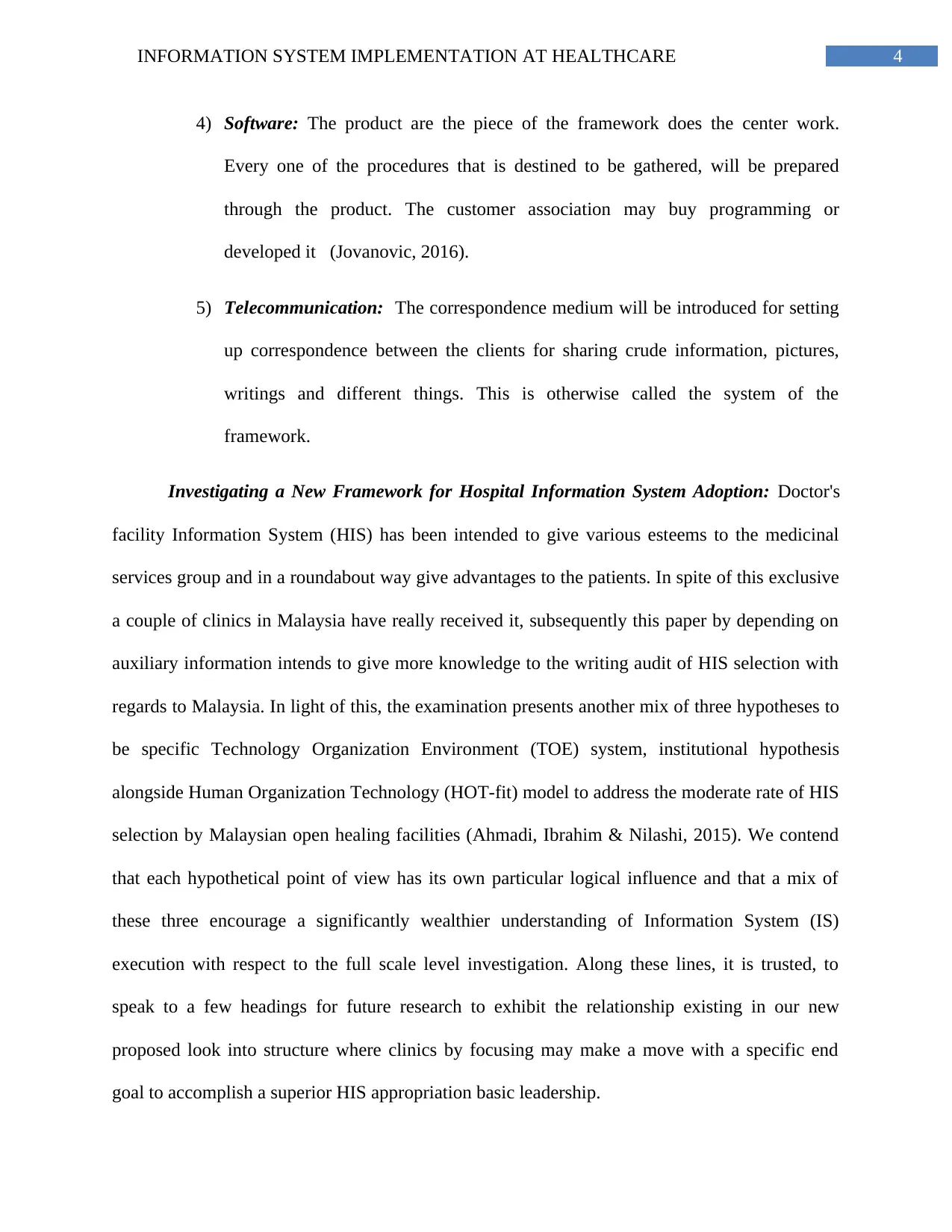
4INFORMATION SYSTEM IMPLEMENTATION AT HEALTHCARE
4) Software: The product are the piece of the framework does the center work.
Every one of the procedures that is destined to be gathered, will be prepared
through the product. The customer association may buy programming or
developed it (Jovanovic, 2016).
5) Telecommunication: The correspondence medium will be introduced for setting
up correspondence between the clients for sharing crude information, pictures,
writings and different things. This is otherwise called the system of the
framework.
Investigating a New Framework for Hospital Information System Adoption: Doctor's
facility Information System (HIS) has been intended to give various esteems to the medicinal
services group and in a roundabout way give advantages to the patients. In spite of this exclusive
a couple of clinics in Malaysia have really received it, subsequently this paper by depending on
auxiliary information intends to give more knowledge to the writing audit of HIS selection with
regards to Malaysia. In light of this, the examination presents another mix of three hypotheses to
be specific Technology Organization Environment (TOE) system, institutional hypothesis
alongside Human Organization Technology (HOT-fit) model to address the moderate rate of HIS
selection by Malaysian open healing facilities (Ahmadi, Ibrahim & Nilashi, 2015). We contend
that each hypothetical point of view has its own particular logical influence and that a mix of
these three encourage a significantly wealthier understanding of Information System (IS)
execution with respect to the full scale level investigation. Along these lines, it is trusted, to
speak to a few headings for future research to exhibit the relationship existing in our new
proposed look into structure where clinics by focusing may make a move with a specific end
goal to accomplish a superior HIS appropriation basic leadership.
4) Software: The product are the piece of the framework does the center work.
Every one of the procedures that is destined to be gathered, will be prepared
through the product. The customer association may buy programming or
developed it (Jovanovic, 2016).
5) Telecommunication: The correspondence medium will be introduced for setting
up correspondence between the clients for sharing crude information, pictures,
writings and different things. This is otherwise called the system of the
framework.
Investigating a New Framework for Hospital Information System Adoption: Doctor's
facility Information System (HIS) has been intended to give various esteems to the medicinal
services group and in a roundabout way give advantages to the patients. In spite of this exclusive
a couple of clinics in Malaysia have really received it, subsequently this paper by depending on
auxiliary information intends to give more knowledge to the writing audit of HIS selection with
regards to Malaysia. In light of this, the examination presents another mix of three hypotheses to
be specific Technology Organization Environment (TOE) system, institutional hypothesis
alongside Human Organization Technology (HOT-fit) model to address the moderate rate of HIS
selection by Malaysian open healing facilities (Ahmadi, Ibrahim & Nilashi, 2015). We contend
that each hypothetical point of view has its own particular logical influence and that a mix of
these three encourage a significantly wealthier understanding of Information System (IS)
execution with respect to the full scale level investigation. Along these lines, it is trusted, to
speak to a few headings for future research to exhibit the relationship existing in our new
proposed look into structure where clinics by focusing may make a move with a specific end
goal to accomplish a superior HIS appropriation basic leadership.
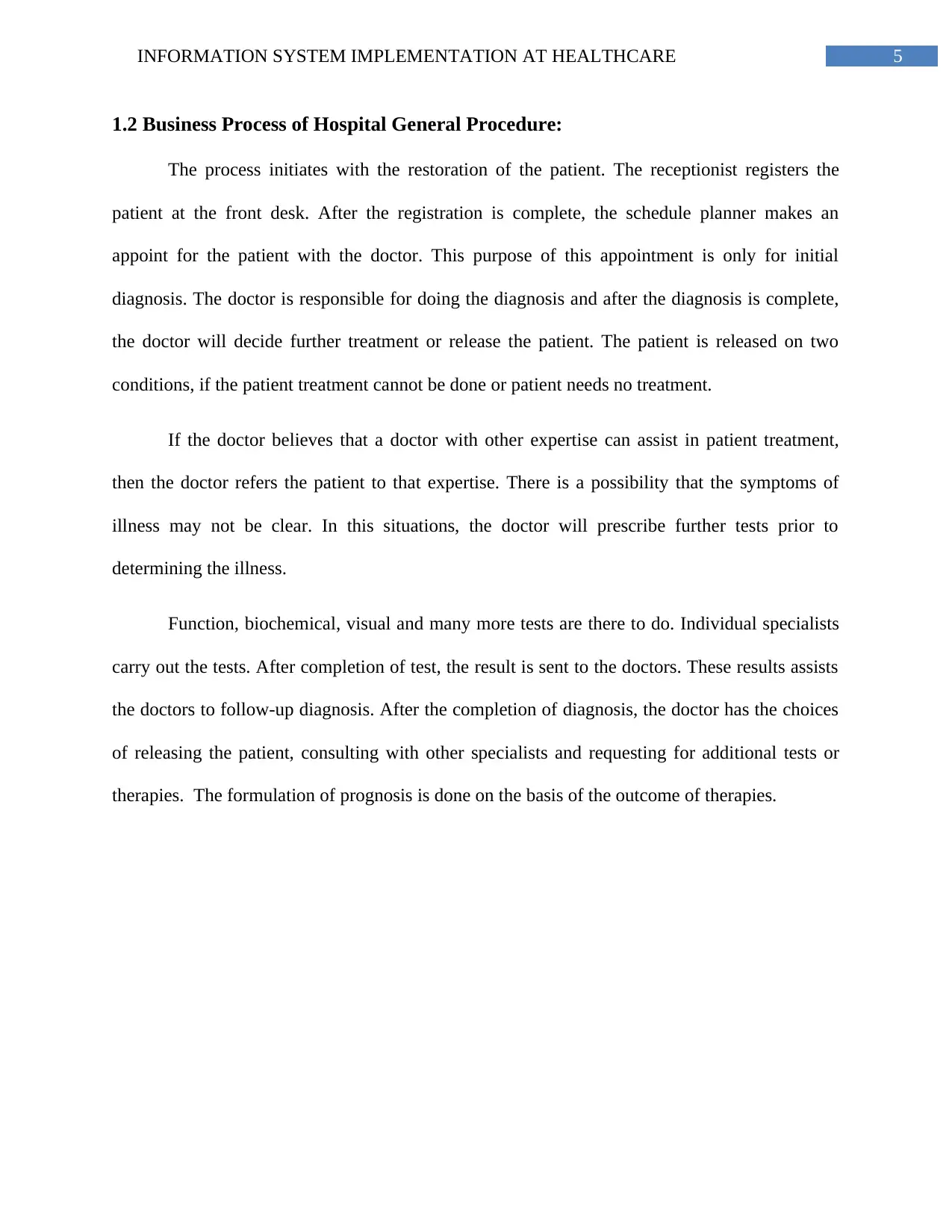
5INFORMATION SYSTEM IMPLEMENTATION AT HEALTHCARE
1.2 Business Process of Hospital General Procedure:
The process initiates with the restoration of the patient. The receptionist registers the
patient at the front desk. After the registration is complete, the schedule planner makes an
appoint for the patient with the doctor. This purpose of this appointment is only for initial
diagnosis. The doctor is responsible for doing the diagnosis and after the diagnosis is complete,
the doctor will decide further treatment or release the patient. The patient is released on two
conditions, if the patient treatment cannot be done or patient needs no treatment.
If the doctor believes that a doctor with other expertise can assist in patient treatment,
then the doctor refers the patient to that expertise. There is a possibility that the symptoms of
illness may not be clear. In this situations, the doctor will prescribe further tests prior to
determining the illness.
Function, biochemical, visual and many more tests are there to do. Individual specialists
carry out the tests. After completion of test, the result is sent to the doctors. These results assists
the doctors to follow-up diagnosis. After the completion of diagnosis, the doctor has the choices
of releasing the patient, consulting with other specialists and requesting for additional tests or
therapies. The formulation of prognosis is done on the basis of the outcome of therapies.
1.2 Business Process of Hospital General Procedure:
The process initiates with the restoration of the patient. The receptionist registers the
patient at the front desk. After the registration is complete, the schedule planner makes an
appoint for the patient with the doctor. This purpose of this appointment is only for initial
diagnosis. The doctor is responsible for doing the diagnosis and after the diagnosis is complete,
the doctor will decide further treatment or release the patient. The patient is released on two
conditions, if the patient treatment cannot be done or patient needs no treatment.
If the doctor believes that a doctor with other expertise can assist in patient treatment,
then the doctor refers the patient to that expertise. There is a possibility that the symptoms of
illness may not be clear. In this situations, the doctor will prescribe further tests prior to
determining the illness.
Function, biochemical, visual and many more tests are there to do. Individual specialists
carry out the tests. After completion of test, the result is sent to the doctors. These results assists
the doctors to follow-up diagnosis. After the completion of diagnosis, the doctor has the choices
of releasing the patient, consulting with other specialists and requesting for additional tests or
therapies. The formulation of prognosis is done on the basis of the outcome of therapies.
⊘ This is a preview!⊘
Do you want full access?
Subscribe today to unlock all pages.

Trusted by 1+ million students worldwide
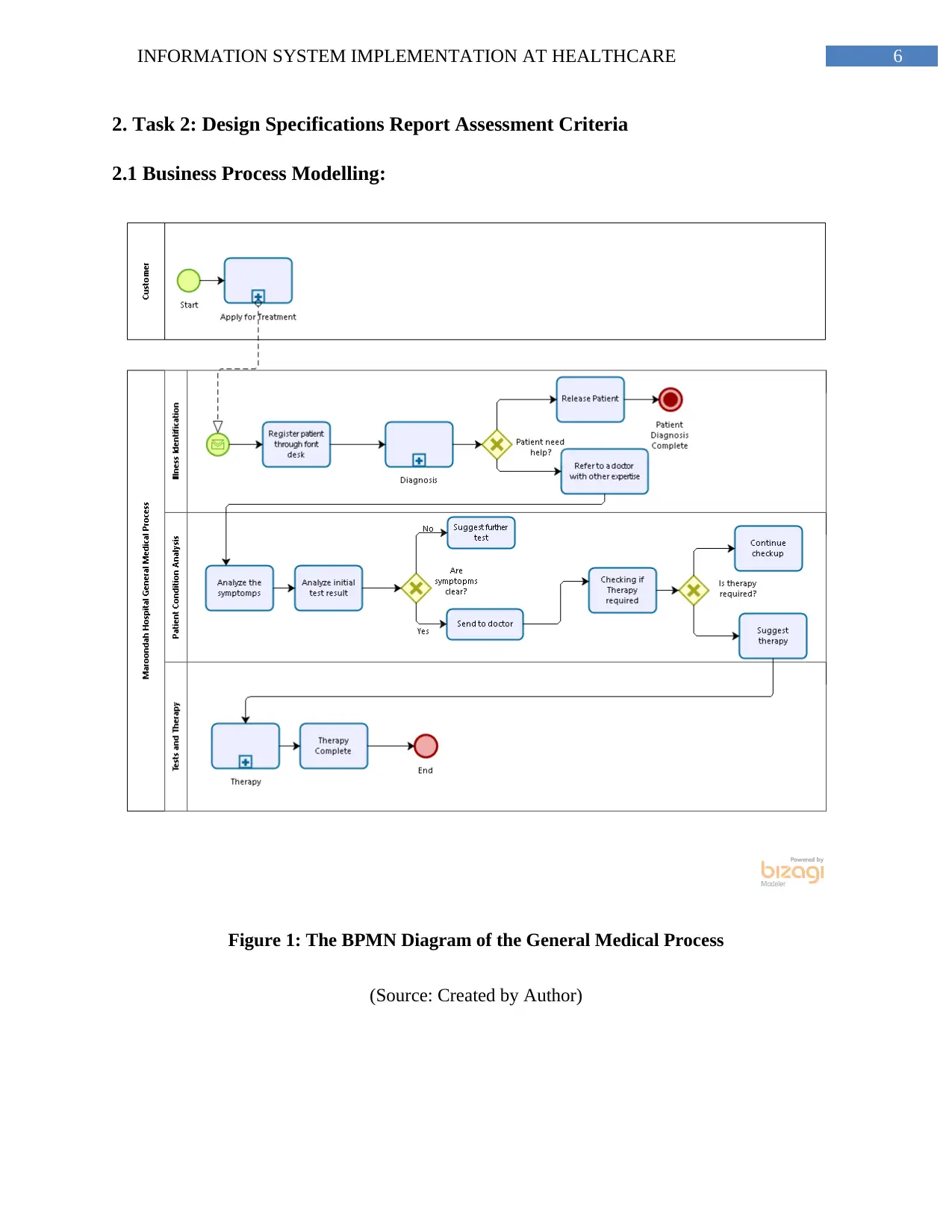
6INFORMATION SYSTEM IMPLEMENTATION AT HEALTHCARE
2. Task 2: Design Specifications Report Assessment Criteria
2.1 Business Process Modelling:
Figure 1: The BPMN Diagram of the General Medical Process
(Source: Created by Author)
2. Task 2: Design Specifications Report Assessment Criteria
2.1 Business Process Modelling:
Figure 1: The BPMN Diagram of the General Medical Process
(Source: Created by Author)
Paraphrase This Document
Need a fresh take? Get an instant paraphrase of this document with our AI Paraphraser
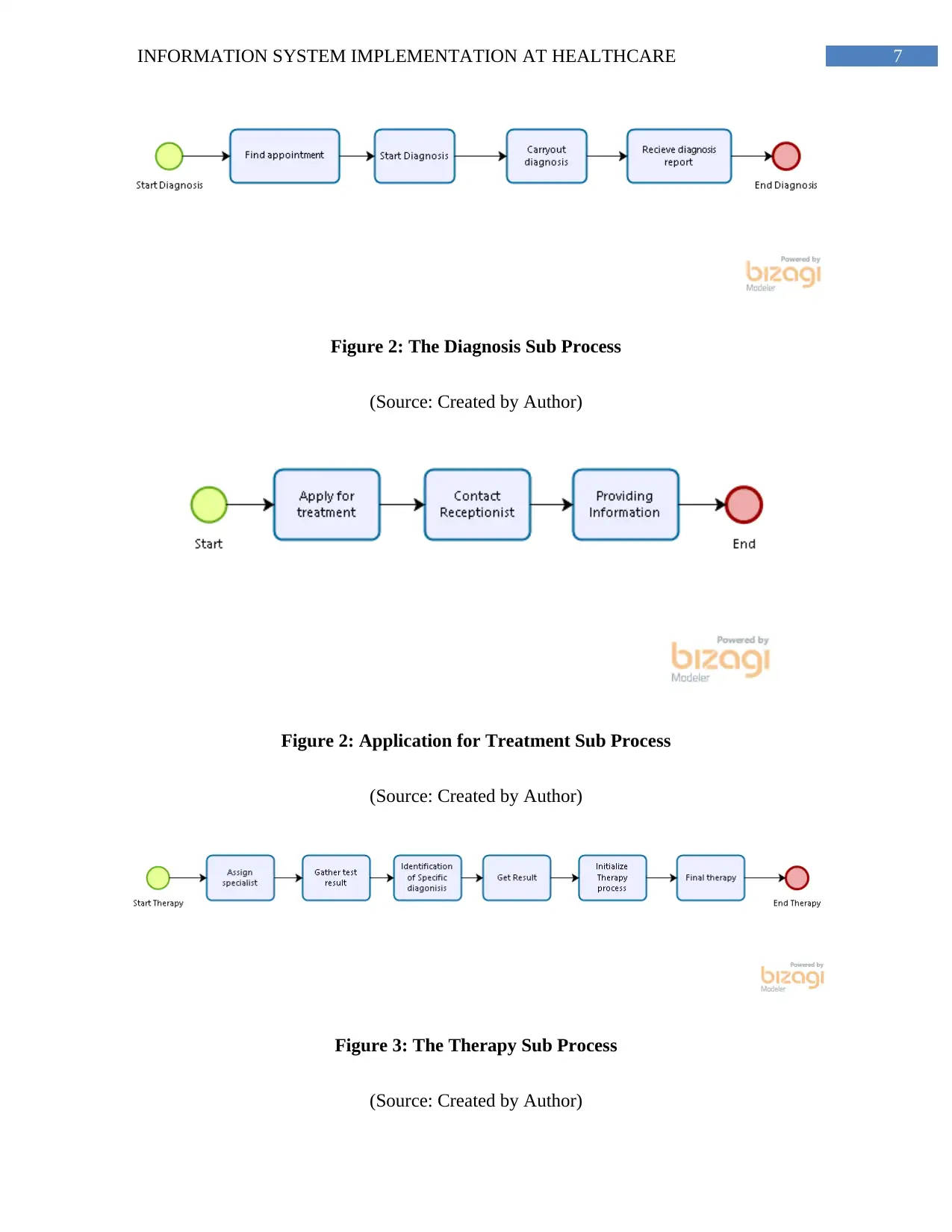
7INFORMATION SYSTEM IMPLEMENTATION AT HEALTHCARE
Figure 2: The Diagnosis Sub Process
(Source: Created by Author)
Figure 2: Application for Treatment Sub Process
(Source: Created by Author)
Figure 3: The Therapy Sub Process
(Source: Created by Author)
Figure 2: The Diagnosis Sub Process
(Source: Created by Author)
Figure 2: Application for Treatment Sub Process
(Source: Created by Author)
Figure 3: The Therapy Sub Process
(Source: Created by Author)
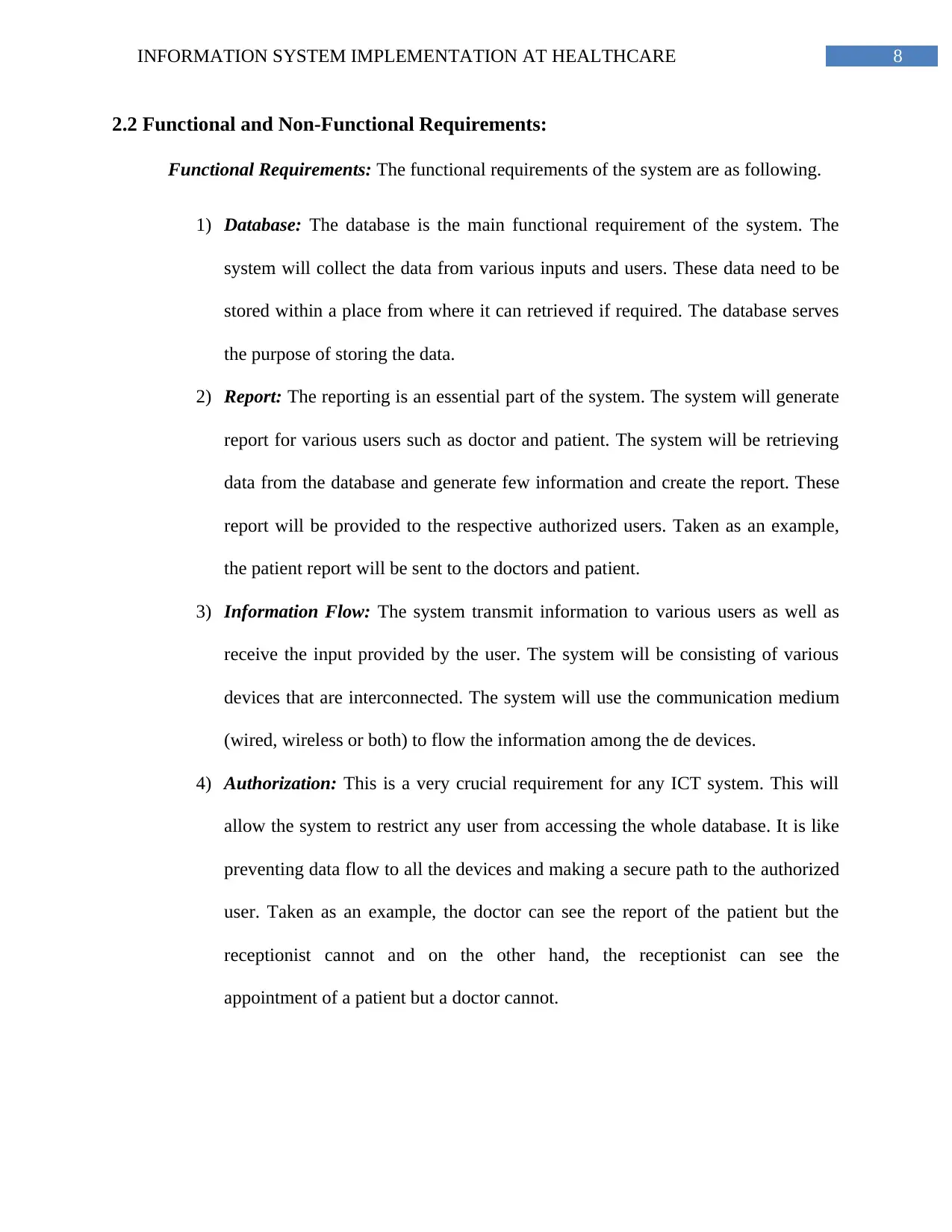
8INFORMATION SYSTEM IMPLEMENTATION AT HEALTHCARE
2.2 Functional and Non-Functional Requirements:
Functional Requirements: The functional requirements of the system are as following.
1) Database: The database is the main functional requirement of the system. The
system will collect the data from various inputs and users. These data need to be
stored within a place from where it can retrieved if required. The database serves
the purpose of storing the data.
2) Report: The reporting is an essential part of the system. The system will generate
report for various users such as doctor and patient. The system will be retrieving
data from the database and generate few information and create the report. These
report will be provided to the respective authorized users. Taken as an example,
the patient report will be sent to the doctors and patient.
3) Information Flow: The system transmit information to various users as well as
receive the input provided by the user. The system will be consisting of various
devices that are interconnected. The system will use the communication medium
(wired, wireless or both) to flow the information among the de devices.
4) Authorization: This is a very crucial requirement for any ICT system. This will
allow the system to restrict any user from accessing the whole database. It is like
preventing data flow to all the devices and making a secure path to the authorized
user. Taken as an example, the doctor can see the report of the patient but the
receptionist cannot and on the other hand, the receptionist can see the
appointment of a patient but a doctor cannot.
2.2 Functional and Non-Functional Requirements:
Functional Requirements: The functional requirements of the system are as following.
1) Database: The database is the main functional requirement of the system. The
system will collect the data from various inputs and users. These data need to be
stored within a place from where it can retrieved if required. The database serves
the purpose of storing the data.
2) Report: The reporting is an essential part of the system. The system will generate
report for various users such as doctor and patient. The system will be retrieving
data from the database and generate few information and create the report. These
report will be provided to the respective authorized users. Taken as an example,
the patient report will be sent to the doctors and patient.
3) Information Flow: The system transmit information to various users as well as
receive the input provided by the user. The system will be consisting of various
devices that are interconnected. The system will use the communication medium
(wired, wireless or both) to flow the information among the de devices.
4) Authorization: This is a very crucial requirement for any ICT system. This will
allow the system to restrict any user from accessing the whole database. It is like
preventing data flow to all the devices and making a secure path to the authorized
user. Taken as an example, the doctor can see the report of the patient but the
receptionist cannot and on the other hand, the receptionist can see the
appointment of a patient but a doctor cannot.
⊘ This is a preview!⊘
Do you want full access?
Subscribe today to unlock all pages.

Trusted by 1+ million students worldwide
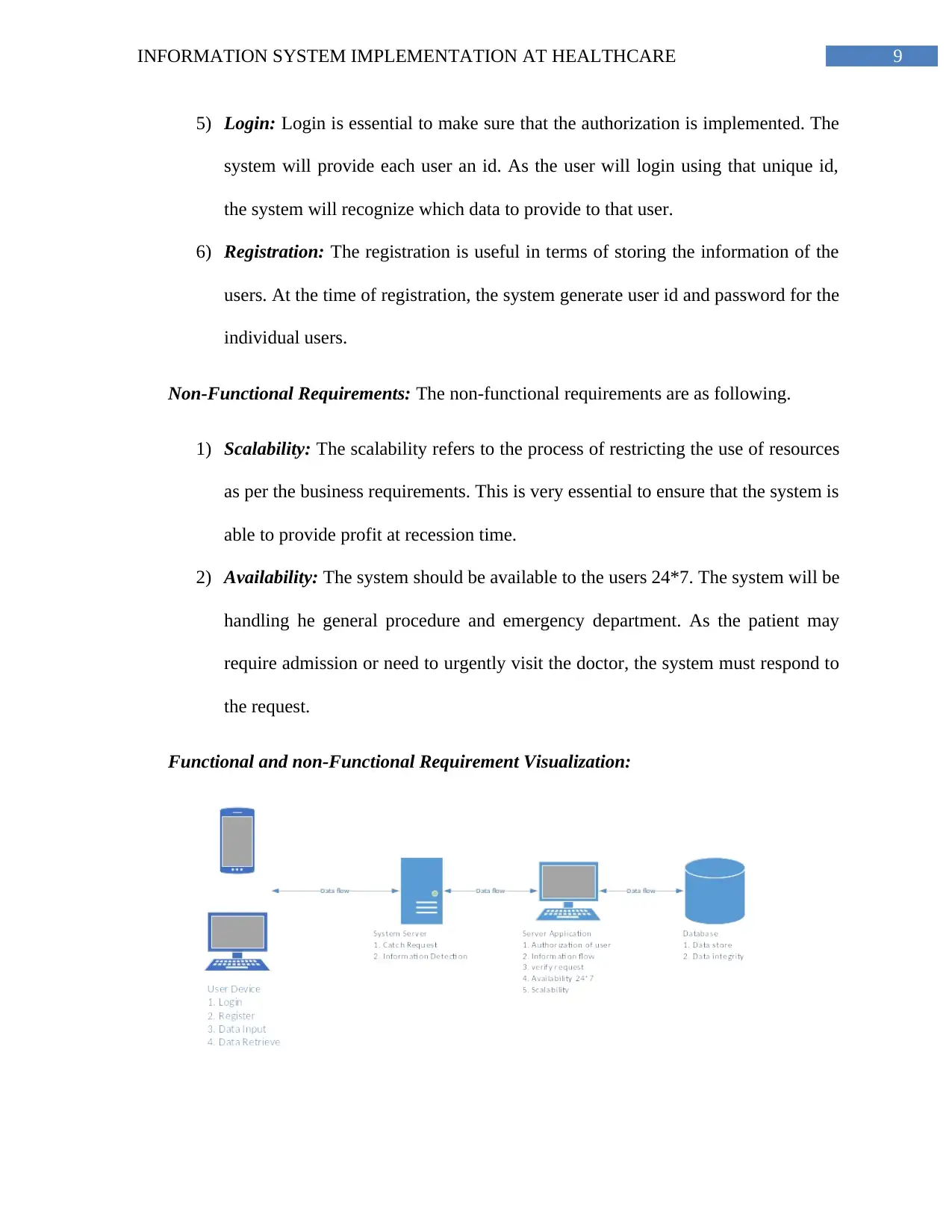
9INFORMATION SYSTEM IMPLEMENTATION AT HEALTHCARE
5) Login: Login is essential to make sure that the authorization is implemented. The
system will provide each user an id. As the user will login using that unique id,
the system will recognize which data to provide to that user.
6) Registration: The registration is useful in terms of storing the information of the
users. At the time of registration, the system generate user id and password for the
individual users.
Non-Functional Requirements: The non-functional requirements are as following.
1) Scalability: The scalability refers to the process of restricting the use of resources
as per the business requirements. This is very essential to ensure that the system is
able to provide profit at recession time.
2) Availability: The system should be available to the users 24*7. The system will be
handling he general procedure and emergency department. As the patient may
require admission or need to urgently visit the doctor, the system must respond to
the request.
Functional and non-Functional Requirement Visualization:
5) Login: Login is essential to make sure that the authorization is implemented. The
system will provide each user an id. As the user will login using that unique id,
the system will recognize which data to provide to that user.
6) Registration: The registration is useful in terms of storing the information of the
users. At the time of registration, the system generate user id and password for the
individual users.
Non-Functional Requirements: The non-functional requirements are as following.
1) Scalability: The scalability refers to the process of restricting the use of resources
as per the business requirements. This is very essential to ensure that the system is
able to provide profit at recession time.
2) Availability: The system should be available to the users 24*7. The system will be
handling he general procedure and emergency department. As the patient may
require admission or need to urgently visit the doctor, the system must respond to
the request.
Functional and non-Functional Requirement Visualization:
Paraphrase This Document
Need a fresh take? Get an instant paraphrase of this document with our AI Paraphraser
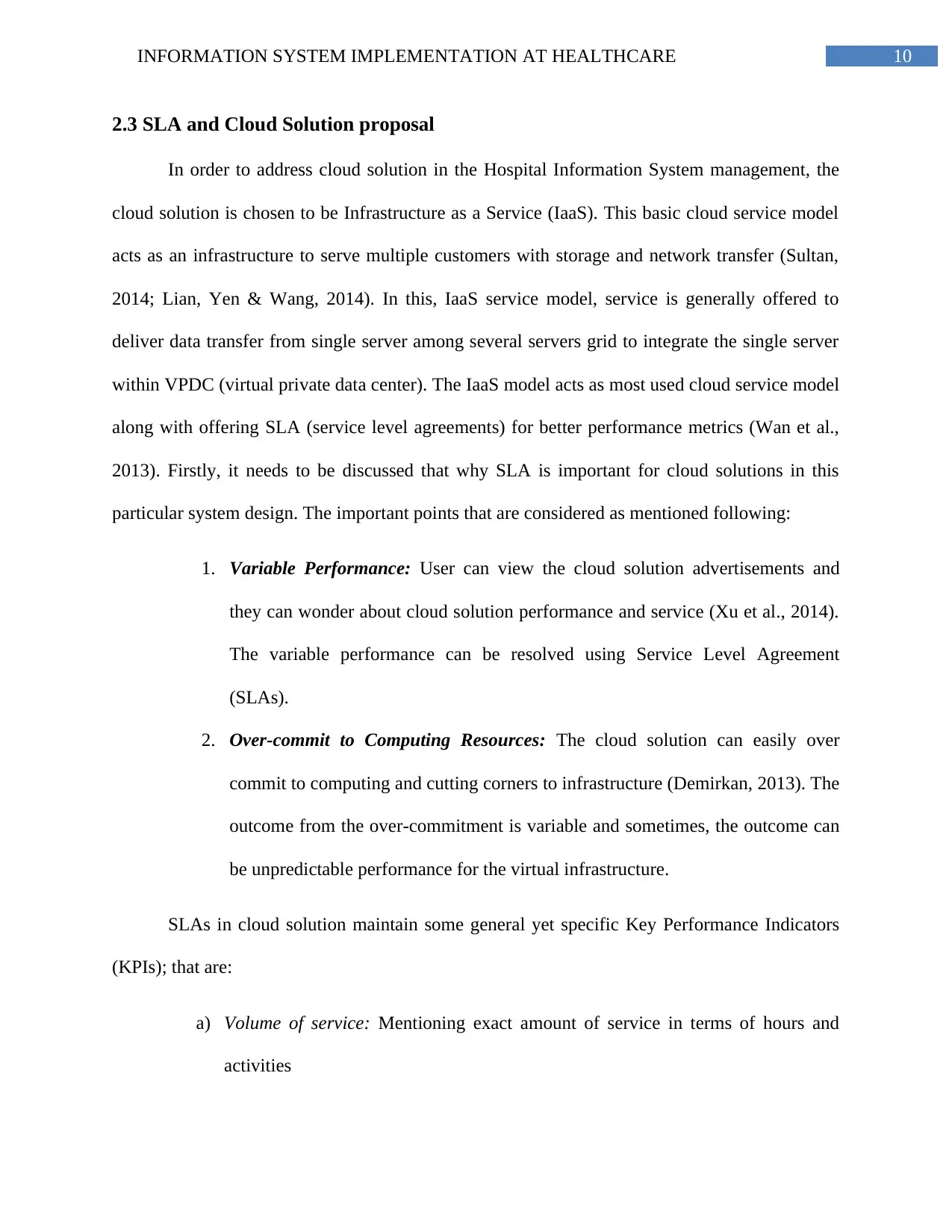
10INFORMATION SYSTEM IMPLEMENTATION AT HEALTHCARE
2.3 SLA and Cloud Solution proposal
In order to address cloud solution in the Hospital Information System management, the
cloud solution is chosen to be Infrastructure as a Service (IaaS). This basic cloud service model
acts as an infrastructure to serve multiple customers with storage and network transfer (Sultan,
2014; Lian, Yen & Wang, 2014). In this, IaaS service model, service is generally offered to
deliver data transfer from single server among several servers grid to integrate the single server
within VPDC (virtual private data center). The IaaS model acts as most used cloud service model
along with offering SLA (service level agreements) for better performance metrics (Wan et al.,
2013). Firstly, it needs to be discussed that why SLA is important for cloud solutions in this
particular system design. The important points that are considered as mentioned following:
1. Variable Performance: User can view the cloud solution advertisements and
they can wonder about cloud solution performance and service (Xu et al., 2014).
The variable performance can be resolved using Service Level Agreement
(SLAs).
2. Over-commit to Computing Resources: The cloud solution can easily over
commit to computing and cutting corners to infrastructure (Demirkan, 2013). The
outcome from the over-commitment is variable and sometimes, the outcome can
be unpredictable performance for the virtual infrastructure.
SLAs in cloud solution maintain some general yet specific Key Performance Indicators
(KPIs); that are:
a) Volume of service: Mentioning exact amount of service in terms of hours and
activities
2.3 SLA and Cloud Solution proposal
In order to address cloud solution in the Hospital Information System management, the
cloud solution is chosen to be Infrastructure as a Service (IaaS). This basic cloud service model
acts as an infrastructure to serve multiple customers with storage and network transfer (Sultan,
2014; Lian, Yen & Wang, 2014). In this, IaaS service model, service is generally offered to
deliver data transfer from single server among several servers grid to integrate the single server
within VPDC (virtual private data center). The IaaS model acts as most used cloud service model
along with offering SLA (service level agreements) for better performance metrics (Wan et al.,
2013). Firstly, it needs to be discussed that why SLA is important for cloud solutions in this
particular system design. The important points that are considered as mentioned following:
1. Variable Performance: User can view the cloud solution advertisements and
they can wonder about cloud solution performance and service (Xu et al., 2014).
The variable performance can be resolved using Service Level Agreement
(SLAs).
2. Over-commit to Computing Resources: The cloud solution can easily over
commit to computing and cutting corners to infrastructure (Demirkan, 2013). The
outcome from the over-commitment is variable and sometimes, the outcome can
be unpredictable performance for the virtual infrastructure.
SLAs in cloud solution maintain some general yet specific Key Performance Indicators
(KPIs); that are:
a) Volume of service: Mentioning exact amount of service in terms of hours and
activities
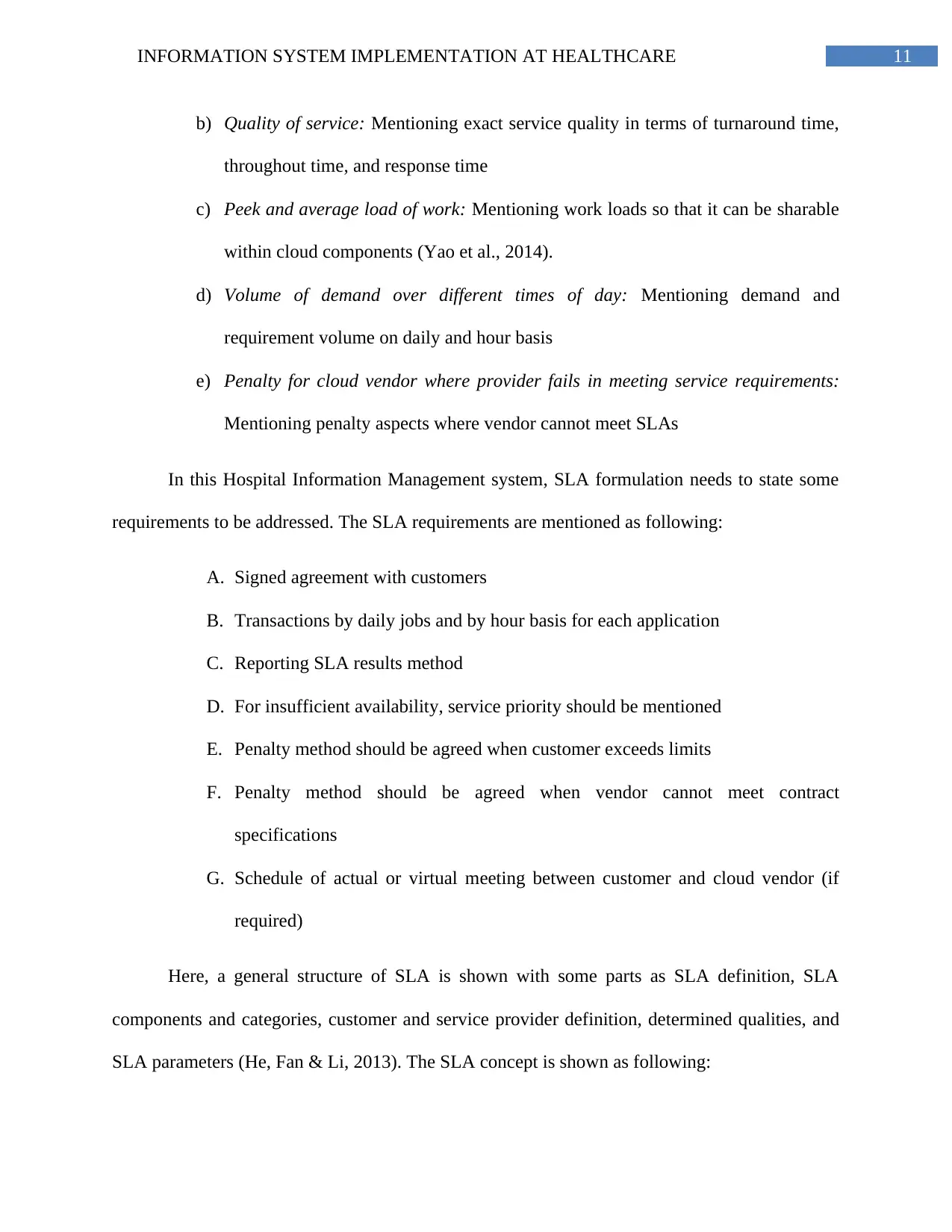
11INFORMATION SYSTEM IMPLEMENTATION AT HEALTHCARE
b) Quality of service: Mentioning exact service quality in terms of turnaround time,
throughout time, and response time
c) Peek and average load of work: Mentioning work loads so that it can be sharable
within cloud components (Yao et al., 2014).
d) Volume of demand over different times of day: Mentioning demand and
requirement volume on daily and hour basis
e) Penalty for cloud vendor where provider fails in meeting service requirements:
Mentioning penalty aspects where vendor cannot meet SLAs
In this Hospital Information Management system, SLA formulation needs to state some
requirements to be addressed. The SLA requirements are mentioned as following:
A. Signed agreement with customers
B. Transactions by daily jobs and by hour basis for each application
C. Reporting SLA results method
D. For insufficient availability, service priority should be mentioned
E. Penalty method should be agreed when customer exceeds limits
F. Penalty method should be agreed when vendor cannot meet contract
specifications
G. Schedule of actual or virtual meeting between customer and cloud vendor (if
required)
Here, a general structure of SLA is shown with some parts as SLA definition, SLA
components and categories, customer and service provider definition, determined qualities, and
SLA parameters (He, Fan & Li, 2013). The SLA concept is shown as following:
b) Quality of service: Mentioning exact service quality in terms of turnaround time,
throughout time, and response time
c) Peek and average load of work: Mentioning work loads so that it can be sharable
within cloud components (Yao et al., 2014).
d) Volume of demand over different times of day: Mentioning demand and
requirement volume on daily and hour basis
e) Penalty for cloud vendor where provider fails in meeting service requirements:
Mentioning penalty aspects where vendor cannot meet SLAs
In this Hospital Information Management system, SLA formulation needs to state some
requirements to be addressed. The SLA requirements are mentioned as following:
A. Signed agreement with customers
B. Transactions by daily jobs and by hour basis for each application
C. Reporting SLA results method
D. For insufficient availability, service priority should be mentioned
E. Penalty method should be agreed when customer exceeds limits
F. Penalty method should be agreed when vendor cannot meet contract
specifications
G. Schedule of actual or virtual meeting between customer and cloud vendor (if
required)
Here, a general structure of SLA is shown with some parts as SLA definition, SLA
components and categories, customer and service provider definition, determined qualities, and
SLA parameters (He, Fan & Li, 2013). The SLA concept is shown as following:
⊘ This is a preview!⊘
Do you want full access?
Subscribe today to unlock all pages.

Trusted by 1+ million students worldwide
1 out of 26
Related Documents
Your All-in-One AI-Powered Toolkit for Academic Success.
+13062052269
info@desklib.com
Available 24*7 on WhatsApp / Email
![[object Object]](/_next/static/media/star-bottom.7253800d.svg)
Unlock your academic potential
Copyright © 2020–2025 A2Z Services. All Rights Reserved. Developed and managed by ZUCOL.





